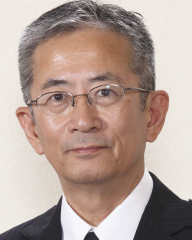Greetings

Resillience Co-Creation Division Nobuo Fukuwa
Amid concerns that a Nankai Trough mega-earthquake and another Isewan Typhoon are imminent in the Tokai region, our university must, as a core university situated in the region, play a leading role in establishing disaster mitigation measures. This center was established in December 2010 against this backdrop. Initially, 30 professors from existing graduate schools also served as professors for the center. With the deployment of six permanent professors in January 2012, the center was officially established. In addition, in April 2012, three additional divisions were established as a result of a donation of industry the center received, thereby consolidating the foundation for promoting industry-academia collaborative research. In April 2014, four additional research professors were assigned. Currently, 17 professors and 28 affiliate professors belong to the center.
In July 2012, the Disaster Prevention and Mitigation College was established; this human resource development program involves collaboration between industry, government, and academia. On March 3, 2013, the Tokai Disaster Mitigation Research Consortium was established by the disaster prevention research centers of six national universities in the Tokai region. With this development, fully-fledged inter-university collaboration began. Further, our university concluded agreements and memorandums with the Chubu Regional Development Bureau, the Disaster Prevention Office of Aichi Prefecture, the Disaster Prevention Office of Nagoya City, nine cities and one town of the West Mikawa area, the Nagoya Urban Institute, and the National Research Institute for Earth Science and Disaster Prevention. Moreover, our university joined a program of broad area collaboration with municipalities in each area of Aichi Prefecture as well as cooperation with industry. Thus, collaborative efforts between industry, government, the public sector, and the university have continued to develop.
On the research front, collaboration between different research fields has advanced as a result of implementing new large-scale projects. These include a research project focusing on compound disaster mitigation on the great earthquakes and tsunamis around the Nankai Trough region; the Tokai disaster mitigation project, in which the abilities of various universities are aggregated in an effort to tackle the threat of a Nankai Trough mega-earthquake; and the Cross-Ministerial Strategic Innovation Promotion Program, which involves establishing a Disaster Mitigation Think Tank which promotes regional cooperation and information sharing.
In March 2014, the Disaster Mitigation Research Building was established as the base for the center’s activities. This building plays a role in the implementation of researches regarding disaster mitigation. In addition, as the first building to have base isolation on the Higashiyama campus, it serves as a disaster-response hub when a disaster strikes. Further, during ordinary times, the first and second floors of the building are open to the public so people can learn about disaster mitigation. Visitors can partake in many activities, including attending lectures about disaster prevention called the “Gallery Talk.” The building is equipped with a range of oscillation devices, and the building itself is an experimental facility for earthquake resistance.
Thirty-seven contract researchers from industry and government have joined our center. The center has gradually consolidated itself as an environment for aggregating the total ability of the region and promoting research, response, and preparedness.
Our center plans to maintain its existing activities, including organizing a range of symposiums, seminars, and other events for citizens such as the “Disaster Prevention Academy,” the “Gen-Sci Café,” and “ESPER” for engineers, (Network for Saving Lives: NSL) for joint study with the media, disaster prevention seminars for high school students, and projects to develop human resources for disaster prevention. At the same time, the center will utilize the Disaster Mitigation Research Building to explore new ways to raise awareness for disaster prevention, thereby moving forward side by side with everyone concerned to realize a disaster resilient society.
